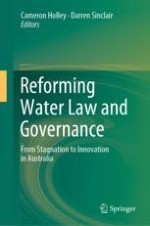2018 | OriginalPaper | Buchkapitel
Environmental Water Transactions and Innovation in Australia
verfasst von : Katherine Owens
Erschienen in: Reforming Water Law and Governance
Verlag: Springer Singapore
Aktivieren Sie unsere intelligente Suche, um passende Fachinhalte oder Patente zu finden.
Wählen Sie Textabschnitte aus um mit Künstlicher Intelligenz passenden Patente zu finden. powered by
Markieren Sie Textabschnitte, um KI-gestützt weitere passende Inhalte zu finden. powered by
